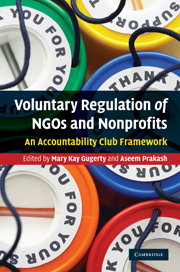Book contents
- Frontmatter
- Contents
- List of figures
- List of tables
- Notes on contributors
- Preface
- The club framework
- Part I Club emergence
- Part II Club sponsorship and club design
- 5 Nonprofit infrastructure associations as reluctant clubs
- 6 Foundation accountability clubs and the search for philanthropic standards
- 7 Do self-regulation clubs work? Some evidence from Europe and some caveats from economic theory
- 8 NGO accountability clubs in the humanitarian sector: social dimensions of club emergence and design
- Part III Club design and effectiveness
- Future research and conclusions
- Index
- References
8 - NGO accountability clubs in the humanitarian sector: social dimensions of club emergence and design
from Part II - Club sponsorship and club design
Published online by Cambridge University Press: 10 November 2010
- Frontmatter
- Contents
- List of figures
- List of tables
- Notes on contributors
- Preface
- The club framework
- Part I Club emergence
- Part II Club sponsorship and club design
- 5 Nonprofit infrastructure associations as reluctant clubs
- 6 Foundation accountability clubs and the search for philanthropic standards
- 7 Do self-regulation clubs work? Some evidence from Europe and some caveats from economic theory
- 8 NGO accountability clubs in the humanitarian sector: social dimensions of club emergence and design
- Part III Club design and effectiveness
- Future research and conclusions
- Index
- References
Summary
In the 1990s humanitarian nongovernmental organizations (NGOs) began questioning how to demonstrate that they were doing good. NGOs looked for ways to improve their performance and the quality of humanitarian aid, and started work on a number of programs aimed at enhancing NGO accountability (Zarnegar Deloffre, 2010). This increased activity resulted from the shared belief that something had changed. Working in a more complex environment characterized by an exponential increase in the number of NGOs, a surge in the amount and types of funding for humanitarian activities, the participation of nontraditional actors, such as militaries and private contracting firms, in aid delivery, and heightened media attention to NGO activities, NGOs came to the conclusion that good intentions were no longer enough. They began defining standards for doing good and created numerous accountability clubs to institutionalize these standards.
In the analytic framework for this volume (chapter 1), Gugerty and Prakash argue that NGOs create and join accountability clubs in response to agency dilemmas – between principals (stakeholders) and agents (NGOs) – that result from information asymmetries. Agency dilemmas, such as shirking, arise when agents pursue their interests over the interests of principals. Gugerty and Prakash contend that NGOs create accountability clubs, defined as “rule-based institutions that create benefits that can be shared by members,” to signal to principals that they are performing per their specifications.
- Type
- Chapter
- Information
- Voluntary Regulation of NGOs and NonprofitsAn Accountability Club Framework, pp. 169 - 200Publisher: Cambridge University PressPrint publication year: 2010
References
- 6
- Cited by



